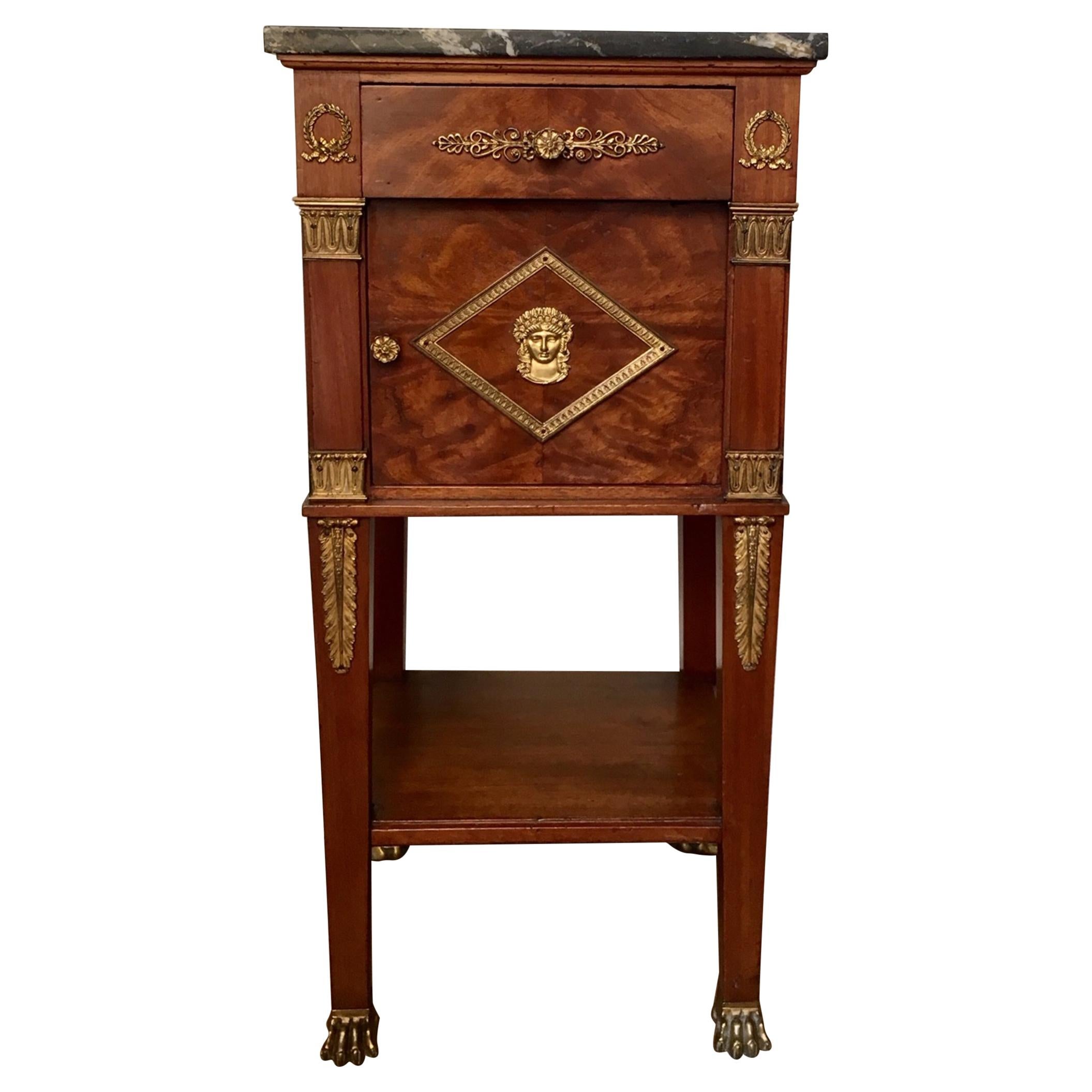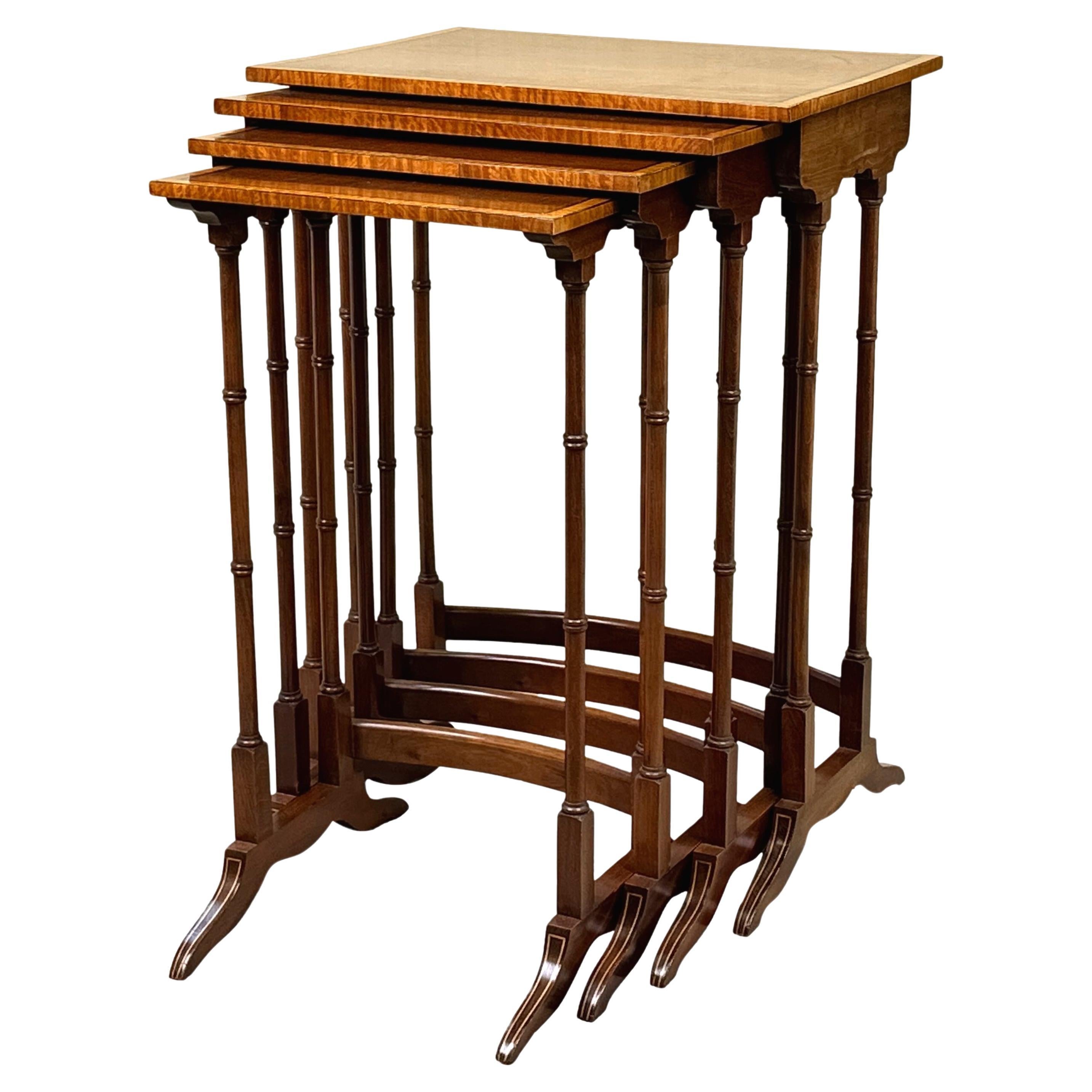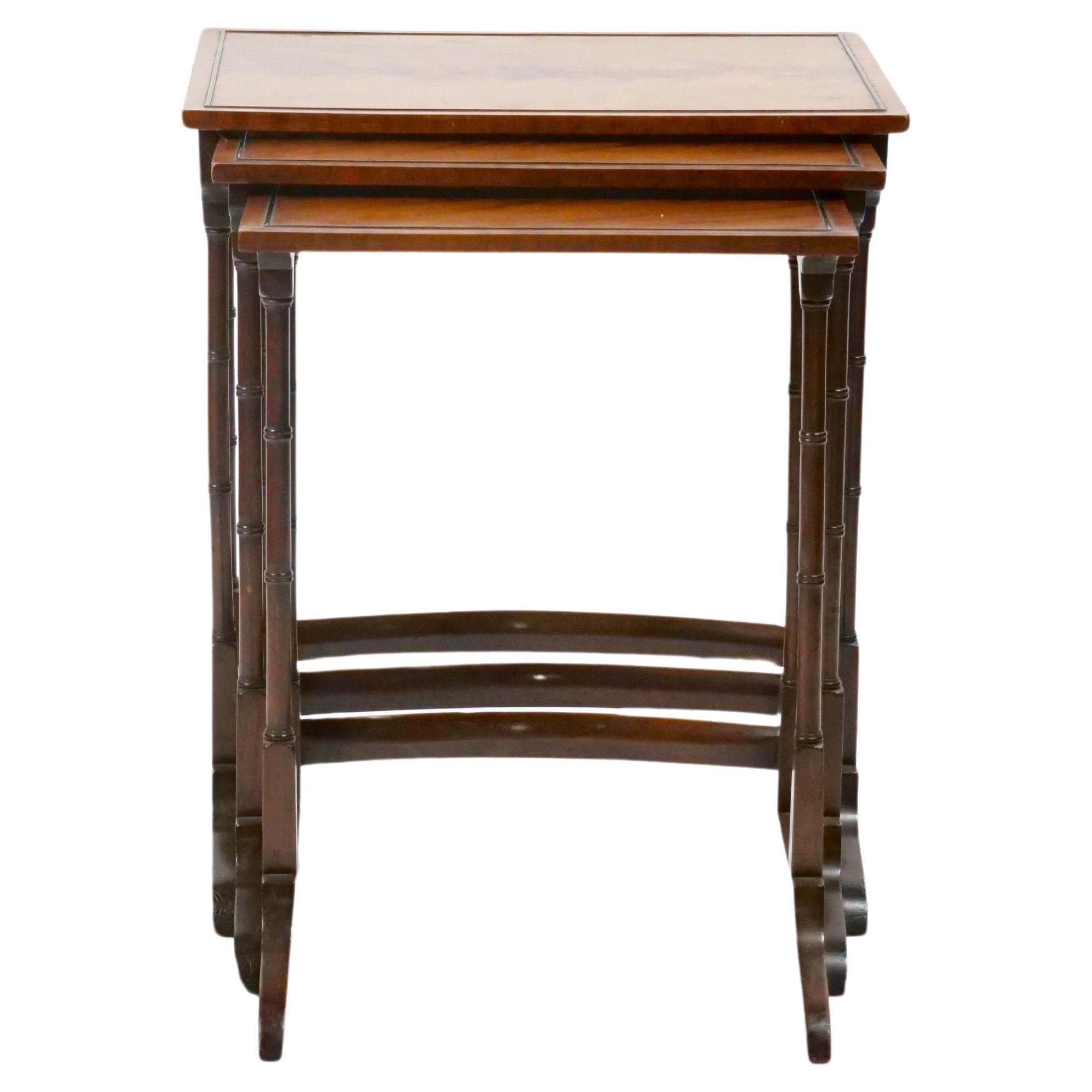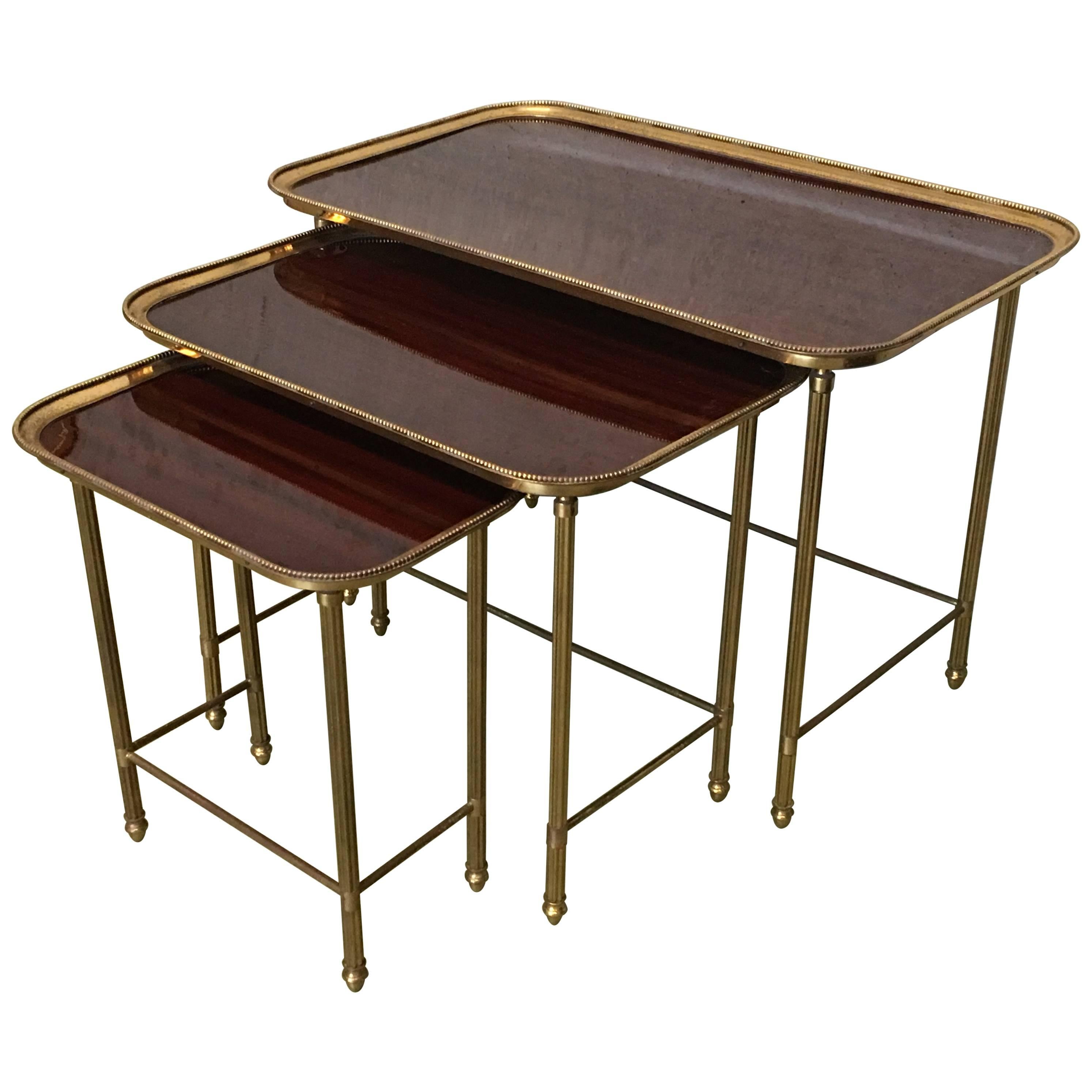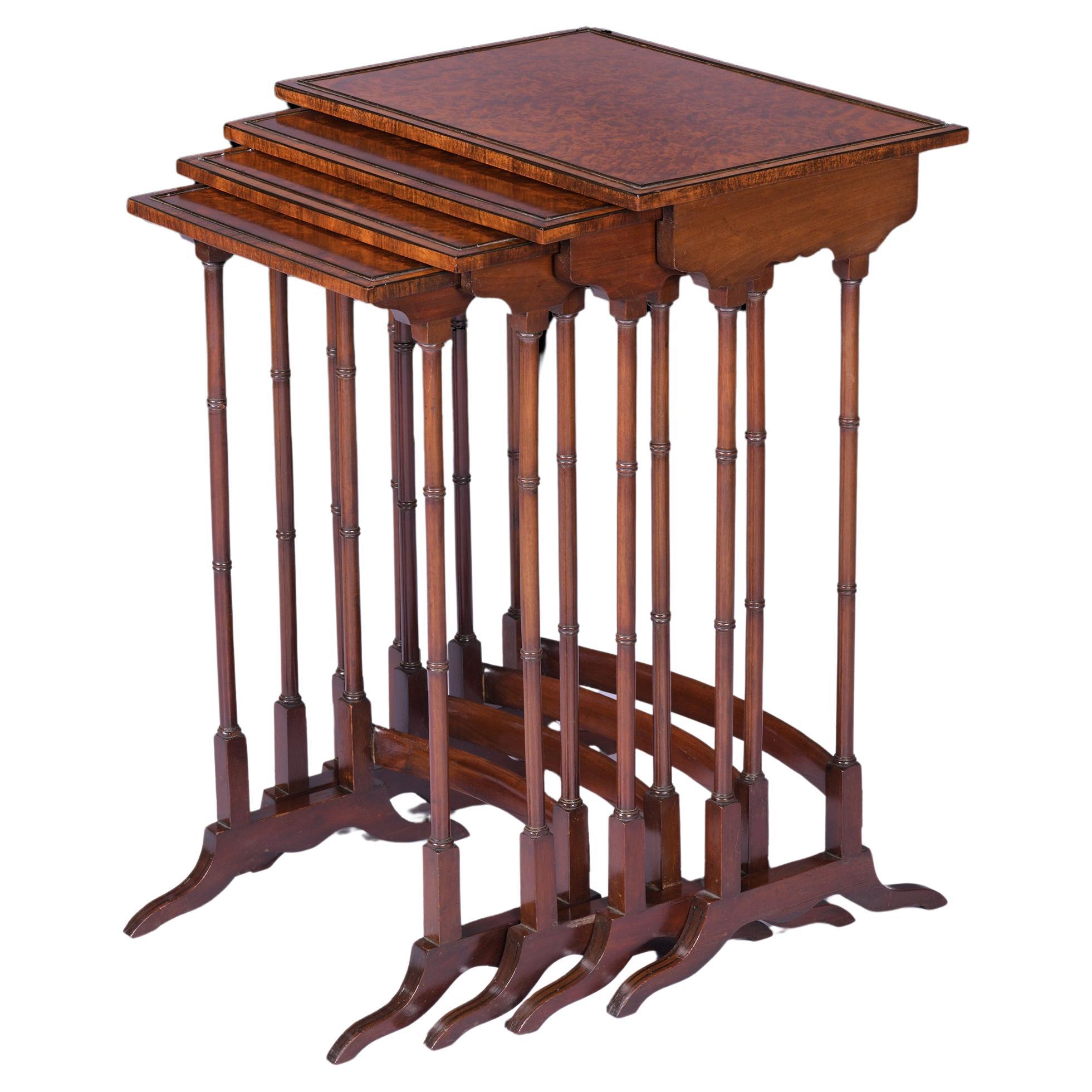Items Similar to Early 19th Century Mahogany Sidetable, Ladies Desk, France, circa 1810
Video Loading
Want more images or videos?
Request additional images or videos from the seller
1 of 15
Early 19th Century Mahogany Sidetable, Ladies Desk, France, circa 1810
About the Item
Empire Lyra writing and work table
Paris
Mahogany
Empire around 1810
Dimensions: H x W x D: 80 x 53 x 34 cm
Description:
Lyra writing and work table based on a design by Pierre de La Mésangère from: Collection de meubles et objets de gout, "Table de Travail".
Two lyres connected by a sturdy cross strut, above which an intermediate shelf in the form of a half-cylinder serves as an intermediate shelf for sewing work, support the high frame, which is divided into two zones by a surrounding profile of gilded bronze. Below the profile is a drawer with a writing surface.
To the right of the writing surface, which can be pushed back when the box is open to reveal the large compartment below, is a row of smaller compartments that were originally used to hold a sandbox, inkwell and pens.
When the table top is raised, the working dish in the upper part of the frame becomes accessible. To the sides of a large open centre compartment are four smaller compartments closed by lids and two recessed grips. A pincushion is attached to one of the lids and a candlestick to another. A large mirror attached to the inside of the table top reflects the light of the candle.
The excellent quality of the materials used, in particular the wood, locks and fittings as well as the very fine, richly fire-gilt bronzes, reflects the precise craftsmanship of the furniture.
Worth knowing:
Pierre de La Mésangère (1761 Pontigné - 1831 Paris) taught literature and philosophy at the college of La Flèche, which was closed during the Revolution. He went to Paris and in 1799 took over the editorship of the "Journal des Dames et des Modes", a fashion magazine similar to the "Magazin des Luxus und der Moden" published by Justin Bertuch in Weimar from 1786.
It reported on all aspects of fashion, interior design and social life. At the same time, regular issues of the magazine "Collection de meubles et objets de goût" were published, in which the latest furniture, textile room decorations and carriages were presented.
Condition:
Absolutely authentic and refurbished to preserve the patina. During the careful restoration, the original polish was only lightly touched up, thus preserving the warm colour of the naturally aged mahogany.
- Dimensions:Height: 31.5 in (80 cm)Width: 20.87 in (53 cm)Depth: 13.39 in (34 cm)
- Style:Empire (Of the Period)
- Materials and Techniques:
- Place of Origin:
- Period:
- Date of Manufacture:1810
- Condition:Refinished. Wear consistent with age and use. Absolutely authentic and refurbished to preserve the patina. During the careful restoration, the original polish was only lightly touched up, thus preserving the warm colour of the naturally aged mahogany.
- Seller Location:Greven, DE
- Reference Number:1stDibs: LU5419238685372
About the Seller
5.0
Platinum Seller
These expertly vetted sellers are 1stDibs' most experienced sellers and are rated highest by our customers.
Established in 2014
1stDibs seller since 2020
115 sales on 1stDibs
Typical response time: <1 hour
- ShippingRetrieving quote...Ships From: Münster, Germany
- Return PolicyA return for this item may be initiated within 14 days of delivery.
More From This SellerView All
- Early 19th Century Mantel Clock, Firegilt Bronze, Paris circa 1810Located in Greven, DEVery rare "Au Bon Sauvage" mantel clock France Fire-gilt and patinated bronze Empire around 1810 Dimensions: H x W x D: 34 x 41 x 13 cm Description: Extremely rare French bronze m...Category
Antique Early 19th Century French Empire Mantel Clocks
MaterialsBronze
- 19th Century Sidetable, France, c. 1890Located in Greven, DEKleines Beistellmöbel mit Rolloverschluss und Schublade. Beistelltisch aus massivem Nussbaum mit dezenten Kontrasten aus Messing. Empirestil, entstanden um 1890. Maße: H x B x T: 7...Category
Antique 1890s French Empire Revival Side Tables
MaterialsWalnut
- Early 19th Century Ormolu Mantel Clock, Atala freeing Chactas, Paris, circa 1810Located in Greven, DEMantel Clock "Atala and Chactas" Paris Bronze (fire-gilt and patinated), enamel Empire around 1810 Dimensions: H x W x D: 40 x 32 x 11 cm Description: Very rare and extremely high quality French mantel clock, so-called Pendule Au Bon Sauvage. Depicted are scenes from the love story "Atala or the love of two savages in the desert" written by Francois René Vicomte de Chateaubriand in 1801. At the beginning of the 19th century, this was probably the most famous love story in Europe, but today it has been forgotten. The story, set in present-day Louisiana (USA), is roughly rewritten about the forbidden love between Chactas, a young Indian, and Atala, the beautiful daughter of a Spaniard. Chactas is captured in a battle between two Indian tribes, chained to a palm tree and is to be sacrificed. Atala wants to save his life and convert him to Christianity. She unties him from the palm tree at night and they flee together into the wilderness of North America. Their love for each other grows stronger and stronger and they have prospects for a future together. The story takes a tragic turn when Atala, who must remain a virgin due to a vow made by her mother, can no longer withstand the conflict of her feelings and commits suicide. The main group of characters thus shows Chacta's liberation through Atala. Atala is leaning against a pile of logs. The animal fur thrown over the logs and the weapons leaning against the stack on the right give the impression of a night camp. The bronze is of rarely beautiful quality, finely chiselled and makes the scene appear very lively. The contrast of fire-gilded and patinated bronze adds tension to the composition. In the base we see the Entombment as the end of the tragic love story. This bronze work is also very detailed, the interplay of bright and matt gilding makes the flat relief appear much deeper than it is. The depiction of the mantel clock presented here shows that the exotic was only known from stories and that the bronzier had his own ideas about the appearance of this distant world. The Indian, for example, has very European facial features and his skin was not black in reality, of course. The palm tree was also certainly not found in the North American wilderness. The heart of the clock is a French pendulum movement, integrated into the wooden pile, with an eight-day power reserve and a lock plate striking a bell on the half and full hour. The pendulum is suspended on a thread, typical of the period. The classically shaped hands, so-called Breguet hands, are also typical of the time. The enamelled dial has black Roman hour numerals, Arabic quarter hours and bears the signature: Le Roy hr. de Madame A PARIS. Interesting facts: The period from 1795 to about 1815 saw the creation of probably the most spectacular group of bronzes: The "Au bon Sauvage" pendulums - depictions of the "Noble Savage". Today's viewers react to these objects with both fascination and irritation. Enthusiastic on the one hand about the obvious quality of the detailed bronzes and the allure of the exotic, on the other hand distanced and cautious because of the possible discrimination that is suspected behind them. The ambivalence of this feeling motivates the search for the conditions of origin of these pendulums. Europeans found their new ideal of the natural man primarily in fictional and realistic travelogues about the Indians of North America...Category
Antique Early 19th Century French Empire Mantel Clocks
MaterialsOrmolu
- Early 19th Century French Empire Bookcase with Safe-Deposit-Box, MahoganyLocated in Greven, DEEmpire bookcase with safe deposit box France Mahogany Empire around 1820 Dimensions: H x W x D: 227 x 154 x 49 cm Description: Impressive Empire ...Category
Antique 19th Century French Empire Bookcases
MaterialsMahogany
- Transforming Ladies Desk, so called Secretaire a Culbute, France, 19th CenturyLocated in Greven, DEConvertible small desk - so-called Secrétaire à culbute France 19th c. Dimensions: H x W x D: 70 x 65 x 47 cm Description: Quite rare and unusual Louis XV style transforming furni...Category
Antique 19th Century French Louis XV Desks and Writing Tables
MaterialsWood
- Ladies Desk, Secretaire En Pente, Bureau De Dames, France, 19th CenturyLocated in Greven, DEAntique ladies' desk - Bureau des Dames - Secretaire en Pente. France second half of 19th century Dimensions: H x W x D: 99 x 92 x 49 cm Description: Impressively beautifu...Category
Antique 19th Century French Secretaires
MaterialsWood
You May Also Like
- Early 19th century French Mahogany Empire DeskLocated in Troy, NYStately Empire desk on four monopodia legs painted a dark verdis gris, joined by two stretchers. Top inset with a tooled black leather writing surface and slide outs (16.5 inches eac...Category
Antique 19th Century French Empire Desks and Writing Tables
MaterialsLeather, Mahogany
- 19th Century French Empire Style Walnut Nightstand Side TableLocated in Madrid, ESFrench Empire side or night table, in walnut wood and original black marble top, a drawer and a cabinet door, with original classic gilded bronze, representing leaves, capitals on it...Category
Antique Mid-19th Century French Empire End Tables
MaterialsBelgian Black Marble, Bronze
- 19th Century Mahogany Quartetto Nest Of Coffee TablesLocated in Bedfordshire, GBA Fine Quality Late 19th Century Mahogany Quartetto Nest Of Four Rectangular Coffee Tables, Having Superbly Figured Panel Tops With Ebonised Stringing And Satinwood Crossbanding, Rai...Category
Antique Late 19th Century English Edwardian Nesting Tables and Stacking ...
MaterialsMahogany
- 19th century Mahogany Inlaid Top Decorated Stacking TablesLocated in Tarry Town, NYEnhance your living space with this set of 19th Century English Burl Mahogany Wood Stacking Tables, a charming and versatile addition to your home...Category
Antique Late 19th Century English Victorian Nesting Tables and Stacking ...
MaterialsMahogany, Burl
- 19th Century Set of Three Nesting Tables in Brass and Mahogany, FranceLocated in Miami, FL19th century set of three nesting tables in brass and mahogany, France Dimensions: Width 28.34, depth 16.73, height 19.88 Dimensions: Width 22.57, depth 13.77, height 18.50 Dime...Category
Antique Mid-19th Century French Neoclassical Nesting Tables and Stacking...
MaterialsBrass
- Antique 19th Century English Mahogany Two-Tier Mechanical TableLocated in New Orleans, LAAntique 19th Century English Mahogany Two-Tier Mechanical Table. Measurements: 41.5 inches in height (up) 31.25 inches in height (down) 43.25 inches in width 25.5 inches in d...Category
Antique 19th Century English Tables
MaterialsMahogany

